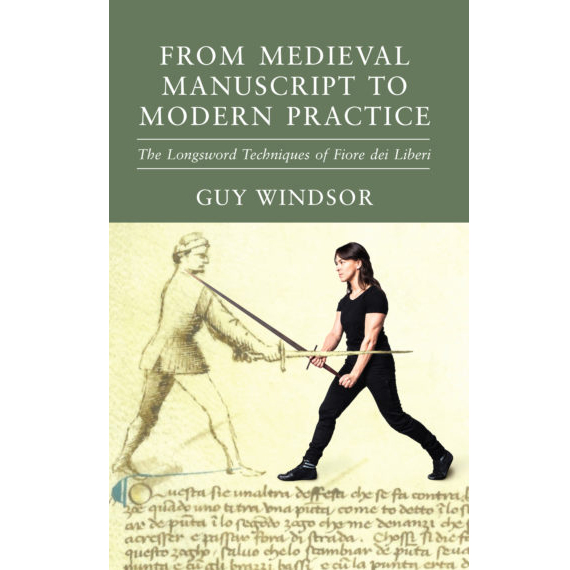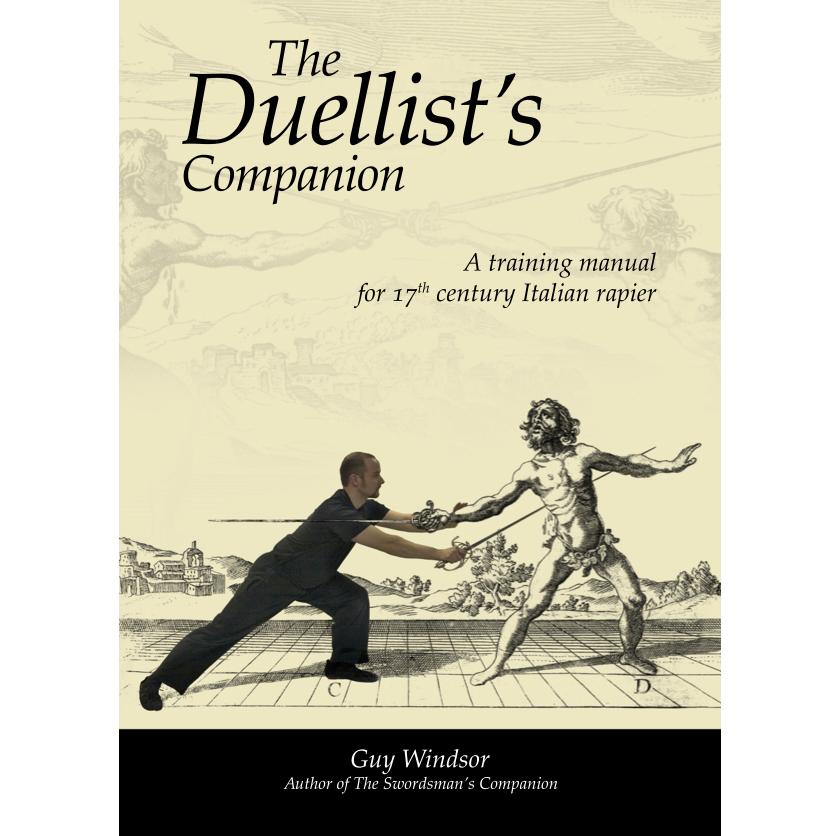
In this special guest blog post, we welcome author and renowned swordsmanship instructor Dr. Guy Windsor, who has spent the last twenty-five years researching, practicing, and teaching Historical Martial Arts. Guy has taken the time to write a blog post for us describing the content and context behind the volumes in his popular collection of HEMA books sold by The Knight Shop.
From Medieval Manuscript to Modern Practice
As a historical swordsmanship instructor, my day job involves finding old books on sword fighting, reading them (which often includes translating them), and figuring out the techniques and tactics of the system the author is describing. You can see this process in my book From Medieval Manuscript to Modern Practice: the Longsword Techniques of Fiore dei Liberi
Fiore’s treatise on the Art of Arms, Il Fior di Battaglia, The Flower of Battle, was written around 1400, and so I start by transcribing the 14th-century Italian handwriting into readable text. Let’s take an example:

The handwriting above reads:
“Questo zogo si chiama punta falsa o punta curta, e si diro come la fazzo. Io mostro d’venire cum granda forza per ferir lo zugadore cum colpo mezano in la testa. E subito ch’ello fa la coverta, io fiero la sua spada lizeramente. E subito volto la spada mia de l’altra parte piglando la mia spada cum la mane mia mancha quasi al mezo. E la punta gli metto subita in la gola o in lo petto. E de miglore questo zogo in arme che senza.”
That’s great, except that most of my students can’t read Italian. So my translation follows:
“This play is called the false thrust or the short thrust, and I’ll tell you how I do it. I show that I am coming with great force to strike the player with a middle blow in the head. And immediately that he makes the cover I strike his sword lightly. And immediately turn my sword to the other side, grabbing my sword with my left hand about at the middle. And I place the thrust immediately in the throat or in the chest. And this play is better in armour than without.”
But how do you actually do it? Here’s the video clip linked to in the book: https://vimeo.com/348188181
This kind of analysis leads to a decent choreographical interpretation of what’s in the manuscript, but choreography is just the start: nobody ever won a sword fight with choreography.
The Theory and Practice of Historical Martial Arts
How do we get from choreographical interpretation to actual fencing skill? The next step is to create working training syllabi for these systems. This is a big subject which I tackle in depth in my book, The Theory and Practice of Historical Martial Arts.
In short, the process involves figuring out the system represented by the various techniques. How do they all fit together into a coherent idea of how to fight?
We must also figure out the pre-requisites: equipment, sure, but also does the source tell us everything we need to know? Such as, how to strike?
Most historical sources are not intended as instructional manuals. They give a more or less accurate and complete picture of the Art of Arms as the author saw it, but they are not organised as pedagogical manuals, with the simplest things first. Fiore, for instance, doesn’t mention footwork until we’re about a third of the way through his book. So we need to establish what the fundamental skills we need are (such as weapons handling, footwork, striking, and so on), and work out how to practice them.
Then we need to work towards internalising the system to the point that when we are under pressure (such as in a fencing match), the actions and decisions we make are in accordance with the system we are practising.
Syllabus design is one chapter of the book, of course, but by itself, a syllabus is just another list of drills. We need to know how to use those drills to develop skills, which we do by practicing in increasingly advanced ways. For example, once you know the choreography of a basic drill which usually has both fencers standing still at the beginning, you can try the same drill with one or other of the fencers in motion. Or perhaps add a degree of freedom to the drill, so that one or another fencer has to react in real-time to what’s going on. By carefully and gradually adding this kind of complexity, we cross the bridge from “I know this” to “I can do this.”
The Medieval Longsword: A Training Manual
You can see how I have developed my interpretation of the longsword plays in Il Fior di Battaglia (as shown in From Medieval Manuscript to Modern Practice) into a working syllabus in my book The Medieval Longsword.
In it I cover covering how to approach your practice, who Fiore dei Liberi was, and what his manuscript contains, before looking at Tools of the Trade: everything you need to know about equipment: training weapons and protective equipment (which you can of course get from The Knight’s Shop!). I then explain the fundamental principles behind all martial arts techniques before getting into the specifics of Footwork: how to stand, step, and turn, according to Fiore’s teachings.
Fiore organises his book as a complete picture of the Art of Arms, not as a training method for modern folk, so I have added in some very basic information like how, exactly, to hold a longsword, and how to learn to move with it. I then give you one simple strike, and one simple defence, and the guard positions you need to make those actions. A guard is the beginning, middle, or end of a strike.
Then I gradually build that up, adding more strikes, more defences, and more guard positions, until you’re ready for Counter Remedies and their Counters: how to get around your partner’s defences, and what to do if your partner manages to get around your defence. That prepares you for “Binds, Malice and Deceit”: how to manipulate the blade relationship to take advantage of the situation, and how to fake out your partner. That gets you ready to think tactically, and to learn real skills, preparing you for Freeplay: taking your technical knowledge and training to be able to really apply it, and then Freeplay itself, setting up safe and useful sparring sessions. Once you have all that, you have built a solid base from which to develop your practice, which I show you how to do in Advanced Longsword: Form and Function.

The Duellist’s Companion: A training manual for 17th century Italian Rapier
If you prefer rapiers, but don’t want to work directly from the early 17th century Italian sources (or perhaps not yet), then you can see the same approach to creating a training method from a choreographical interpretation in my book The Duellist’s Companion.
With it you will learn how to choose your sword and equipment, all the basic footwork and body actions, how make your sword go exactly where you want it to, as well as the basic techniques from Ridolfo Capoferro’s Il Gran Simulacro dell’arte e dell’uso della scherma (The Great Representation of the Art and Use of Fencing). We then build on that to develop actual fencing skill with increasingly sophisticated actions, as well as learning how to use the rapier and dagger together.
The practice of historical martial arts as I see it comprises four stages: reading the source, reproducing the techniques the source represents, organising those actions into a syllabus, and then training with that syllabus to develop martial skill. My books make every aspect of every stage transparent, enabling the next generation of historical martial artists to surpass my own.




